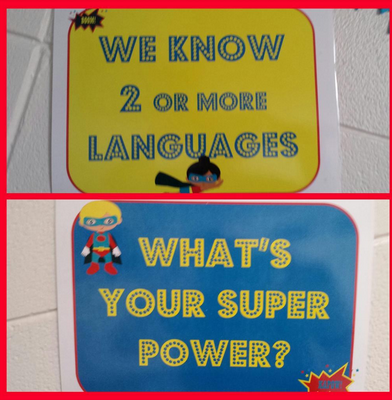Help! I have a student that doesn’t speak English!
When I tell people I teach ELL (this is the acronym my state used at one point: English Language Learner) the next question is almost always, “Do you speak another language?” People are generally shocked when I tell that I don’t speak any other language (save for a tiny bit of terrible Spanish). It wouldn’t really matter if I did because I have worked with students that have spoken at least 30 different languages. The follow up in this conversation is “How to do you teach someone who doesn’t speak English at all?” This is a tough, but important question. I thought I would write this blog post to help teachers that might have a new student who doesn’t speak English. Disclaimer!!! This may not be the most PC article written, but I am always incredibly respectful of my students, their languages and their cultures. Sometimes your techniques and questioning of these students may not be PC, but using PC language can be unnecessarily confusing for ELL students. Disclaimer 2!!!! I will not be quoting articles or textbooks, these tips are solely based on my experience as a teacher. Maybe you have learned that some of these tips aren’t what your professor recommends. I don’t care! These are things that have worked for me in the real world!
These are some of my top tips. Some may seem obvious, but you never know. I think it’s also important to realize that you are probably already doing things that are really great for ELL students and hopefully this article will reinforce that for you.
#1 Smile
This may sound ridiculous, but I am always super bubbly and friendly with non-speakers. They have to see you as someone who has compassion and understanding. If they don’t feel safe with you, they will have a very hard time learning from you and taking risks in your room. So even if this is the 10th new kid you have this year, and you just finished re-doing your grade book, and you don’t have enough desks and the student showed up with zero supplies….Smile!I also mention this because some people have very strong feelings about immigrants, legal or not. I beg you to leave your political beliefs aside. No matter the circumstances for being in this country, these parents are dropping off their most precious possession in a building where they cannot communicate and their child cannot communicate. I can only imagine how terrifying this must be. I can almost 100% guarantee that it was not the child’s decision to come to the USA. Please don’t let your feelings about this subject affect your relationship with this kiddo.
#2 Pictures
This one gets easier and easier with technology. We have real time access to pictures of nearly everything….ever…in the world. That’s pretty cool! Have an ipad, or your phone at the ready so you can pull up a picture of anything you need. Take pictures of places and people in your school and classroom. I use google images because that’s what I know and what I am comfortable with. I have learned that you never want this projected in your class because heaven only knows what pictures may pop up on your seemingly innocuous search! So find the pic, then reveal the screen to the kiddo. This also is very effective for them to show you what they mean. They can google in their language (depending on their native alphabet) and show you what they are trying to say.#3 Online translators
These are sometimes more trouble than they are worth. I found them more effective with older kids that can read in their native language. People also constantly criticize these tools as not being correct translations, but hey, it’s better than nothing! It may also give your student a bit of security blanket when they first arrive. Not all translators are created equal and not all ESL students learn in the same way. Give it a try, you and your student might really like it.#4 Buddy System
You know that little girl in your class whose lunch box and backpack match, her desk is spotless, and she’s always asking if she can pass out papers or help in some way? Recruit her now! If this little busybody is friendly, responsible and talkative she is your new BFF. She will make sure that newbie has the right colored folder out, gets in the right bus line, and throws away their lunch garbage at the right time. This is the caveat: she will need help (not just from you). Working with someone who can’t talk to you is very exhausting mentally. She cannot be everything to this child. I usually find someone else to be their lunch or recess buddy. If it seems like she is being too bossy or that your newbie is relying on her way too much, change her out for a new recruit.I also enlist the help of a charismatic boy. I have a private meeting with the “cool kid” and ask for them to make sure the newbie has a friend or playmate at recess.
#5 Get the whole class in their corner
Read a story to your class that shows what it is like for a newbie. I like One Green Apple for older kiddos or The Cow That Went Oink for younger kids. Explain that they will need to be patient and helpful with their new friend and show them the ropes.I NEVER force a newbie to speak in front of the class until they are ready and willing. I really make a huge deal about celebrating it with the whole class when they first volunteer to read or answer a question. That truly takes guts!
If I’m able to find a book in their native language I will attempt to read it out loud. I know I sound horrible, and that is kind of the point. They see you taking the risk and they see that you respect their native language.
#6 Speak louder and slower
This is sort of standing joke when it comes to speaking with non-English speakers, but it does kind of work. Now hear me out! I am not saying to just keep repeating yourself louder and slower, but definitely speak louder and slower. Much of the time your student may know some English, but hearing it at a normal pace is too fast for them. Also if you want them to repeat what you have said you have to slow it down for them.I only include the “louder” part because whenever I’m trying to hear something important on the radio or news, I turn up the volume. Please don’t scream in their face, but make sure they can hear you clearly.
#7 Games and Puzzles
I should really make this tip #1, because I find it the most effective yet most under-utilized tool in the classroom. There are so many games that require almost no English that your student has probably played or can figure out just by watching (think checkers, uno, tic-tac-toe). Not only do these games teach strategy and thinking skills, but they lower inhibitions and make your students more relaxed. Have them work on a puzzle with another student. It gives their brain a break from translating and will make them feel at home. I promise!#8 Coloring or “playing” with technology
So many times I hear teachers feeling guilty for having their newbie just color because they don’t have the time (or honestly patience) to try to explain something to them. THAT is OKAY!! Newsflash: most of what you are doing in your room is going to be too difficult for a non-speaker to do! In an ideal world we would have endless resources and time to differentiate everything we do for every level of proficiency. We don’t. Give yourself a break, you’re doing the best you can. As I have mentioned, working with a non-English speaker is not only exhausting for you, it is very exhausting for them. They need lots of breaks, like seriously several each morning and afternoon. This does not make either you or the student lazy. Chances are if you don’t have the patience, they probably don’t either. Letting them figure out a fun app or doing a coloring sheet is fine sometimes. Obviously, I don’t condone plopping them in front of Rosetta Stone for 6 hours a day. However, if 3 out of their Daily 5 are “Listen to Reading” for their first few weeks, I think that’s fine.#9 Act it out
I put this in reluctantly because I am NOT a puppet show, silly voice, sing it out kind of teacher. What can I say, I just don’t have it in me. I think I make up for this short coming in other areas, and my classroom is very fun, so don’t judge!I will “act out” what to do in a fire drill, or how to get hot lunch, or how we get in line. I also act out words like scary, happy, tall, etc. Never take for granted that they understand what a word means. They all learn that if they nod and smile you will leave them alone. Plus they love when you look foolish!
#10 Do they really know NO English??
I mention this because more than a few times as a teacher I have been assigned a student who seems to not speak English at all, like not one word. I will pass out a worksheet and find that not only do they have impeccable handwriting, they know every single word on the paper. Hmmmmm, I find this very interesting. Once I have spent some time with the student and they seem to understand some of what I’m saying, I do a little probing. Many (I would ALMOST say most) countries teach some amount of English in school. There is a very good chance they have learned some English from someone who is not American. Maybe they learned from a Brit or Aussie, maybe they learned from a native Chinese speaker who learned English as a second language. Whatever the case, they didn’t sound like you! Congratulations, you just hit the ELL student jackpot! Typically their initial screener will show very low proficiency, but they will be speaking like an American in mere months! Everyone will ask how you did it, how did you teach them English so fast? Just smile and say “It was nothing.”I’m anxious to hear ideas you have tried and worked with ELL students!







